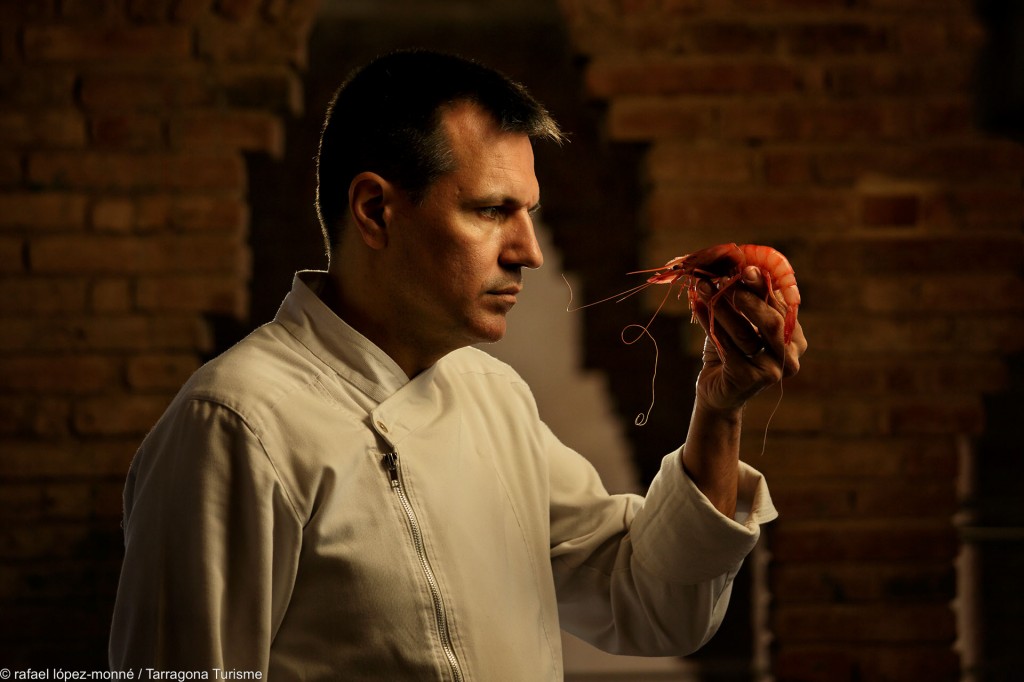From the head to the tail, from the skin to the legs; “We use every single part of the Tarragona Shrimp”, says chef Oriol Castro while cutting off some of them, recently brought from Serrallo… and then, he wow us with an infusion made out of the crustacean’s remainders and chicken stock. Ferran Adrià’s right-hand man deals with cooking pots like magicians do with stovepipe hats. He’s got that kind of magic in his hands of the kind of person that, despite ruling the world with spherifications, new textures and deconstructions, hasn’t forgotten that “respect for the ingredients” is the key for an exceptional dish.
There’s nothing like homemade calamari, which he occasionally fishes with his father at night-time in Torredembarra; or like the home-grown hazelnuts a friend of him grows in Vila-seca, also executive chef at elBulli, Eduard Xatruch, one of his partners now at Compartir, located in Cadaqués, and Disfrutar restaurant, in Barcelona, together with Mateu Casañas. “The Tarragona Shrimp is a top-notch product and provides us with a lot of possibilities. The only problem is, just like other local products, it has been missing a proper recognition. This is the way to start”, he says.
This is precisely why the trademark Tarragona Shrimp (Gamba de Tarragona) was born, to which Castro gives support; with the purpose of making this A-grade product, as he says, known around the world, despite not matching commercially Ràpita’s prawns, Delta’s mussels and oysters, or its sister in the Costa Brava, Palamós’ shrimps. “In order to assess a product, one must first get to know it. The Tarragona Shrimp is an extraordinary crustacean, which requires a lot of work to capture –between February and May–, and that should always by eaten freshly caught. It doesn’t matter it is from Tarragona, or that we appreciate the effort required and origin, if we then leave it in the fridge to waste for three days”, explains Oriol Castro.
The special conditions known as “aiguabarreig” we find in river Ebre’s mouth, the one with the highest flow rate in Spain, turn Costa Daurada’s sea floor into an exceptional organic bed. In this habitat, the population of red shrimps (Aristeus antennatus) has developed a very strong and unique membrane that joins the head and thorax, a structural strength that makes it easier to then maintain the substances from the soft parts of the head and the meat’s flavour, which turns it in the true star of rice dishes, grills and “romescos” in the restaurants of Tarragona. By creating a single trademark, Tarragona Turisme and Tarragona Gastronòmica are willing to make it commercially visible.
Professionally born in elBulli, Castro knows exactly how to become absolutely renown. As the international gastronomic model he is, he based his success on a recipe that combines talent, passion, intuition and dedication, a lot of dedication for cooking, a professional appeal and lifestyle that will never make him feel bored. It was this curiosity that took him to learn how to cook with his mother, specializing as a grown-up in the prestigious school Joviat, in Manresa. In the mid 90s, he started to work for Ferran Adrià without earning a penny. He knew exactly what he was doing. Shortly afterwards, and he was not wrong, his name would shine in a sky full of Michelin stars.
And, despite becoming a model on innovation, Ferran and Albert Adrià’s constant companion in elBulli’s creativity centre, a devoted to the development of new techniques and concepts, Castro has never stopped looking backwards. “Cim i tombes”, “romescos”, “masquetes”, “brutesques” and “rossejats”, the typical dishes preferred by local fishermen cooked using only daily catches and a few other things, which they would then share on board, “are an unforgettable heritage, the essence of modern cuisine”, says the man still taking part in the current Bulli Foundation, which seems to be looking for the right moment to reopen the restaurant they actually shut in 2011. “We need to look ahead with bravery, we need to lose our fears when trying to do certain things; but we shall not forget where we come from”, explains. This new point of view includes, for example, using some of the ingredients no longer available in a current market, such as Moixina (Blackmouth catshark), a shark species very abundant in the Mediterranean that tastes absolutely delicious.
It is precisely in this context, in the combination of what is new and what is old, in a Tarragona and Serrallo where fishermen and restaurateurs are looking in the same direction, that red shrimps are in its right element. “We can cook it in every imaginable and sustainable way; in a more traditional or innovative way, but… may I just make a suggestion?” –Of course. “Let’s not denature it; let’s respect it. Let’s make ourselves a favour by eating it in one piece, and not as a mousse”, finally explains the man that has been in the emergence of Catalan cuisine in an international level.
Text: Oriol Margalef (@OhMargalef on Twitter)
Pictures: Rafael López-Monné
Translation: Artur Santos (@artur_1983 on Twitter)




